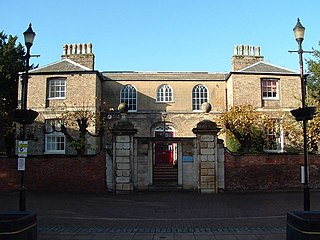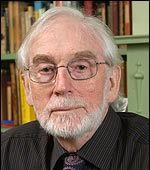
Cambridgeshire or the County of Cambridge is a ceremonial county and historic county in the East of England and East Anglia. It is bordered by Lincolnshire to the north, Norfolk to the north-east, Suffolk to the east, Essex and Hertfordshire to the south, and Bedfordshire and Northamptonshire to the west. The largest settlement is the city of Peterborough, and the city of Cambridge is the county town.

The Fens or Fenlands in eastern England are a naturally marshy region supporting a rich ecology and numerous species. Most of the fens were drained centuries ago, resulting in a flat, dry, low-lying agricultural region supported by a system of drainage channels and man-made rivers and automated pumping stations. There have been unintended consequences to this reclamation, as the land level has continued to sink and the dykes have been built higher to protect it from flooding.

Wisbech is a market town, inland port and civil parish in the Fenland district in Cambridgeshire, England. In 2011 it had a population of 31,573. The town lies in the far north-east of Cambridgeshire, bordering Norfolk and only 5 miles (8 km) south of Lincolnshire. The tidal River Nene running through the town is spanned by two road bridges. Wisbech is in the Isle of Ely and has been described as "the Capital of The Fens".

Fenland is a local government district in Cambridgeshire, England. It was historically part of the Isle of Ely. The district covers around 500 square kilometres (190 sq mi) of mostly agricultural land in the extremely flat Fens. The council is based in March. Other towns include Chatteris, Whittlesey and Wisbech.

William Ellis was a British missionary and writer. He travelled through the Society Islands, Hawaiian Islands, and Madagascar, and wrote several books describing his experiences.

Peckover House & Garden is a National Trust property located in North Brink, Wisbech, Isle of Ely, Cambridgeshire, England.

Wisbech Castle was a stone to motte-and-bailey castle built to fortify Wisbech on the orders of William I in 1072, it probably replaced an earlier timber and turf complex. The layout was probably oval in shape and size, on the line still marked by the Circus. The original design and layout is unknown. It was rebuilt in stone in 1087. The castle was reputedly destroyed in a flood in 1236. In the 15th century, repairs were becoming too much for the ageing structure, and a new building was started in 1478 under John Morton, Bishop of Ely. His successor, John Alcock, extended and completed the re-building and died in the Castle in 1500. Subsequent bishops also spent considerable sums on this new palace. The Bishop's Palace was built of brick with dressings of Ketton Stone, but its exact location is unknown.

Parson Drove is a fen village and civil parish in the Isle of Ely, Cambridgeshire, England. A linear settlement, it is 6 miles (10 km) west of Wisbech, the nearest town. The village is named after the central thoroughfare along which the village developed, a green drove, much wider than the current metalled road (B1166). The population at the 2001 Census was 1,030. The city of Peterborough is 19 miles (31 km) to the west, and the town of King's Lynn is 21 miles (34 km) to the east.

Walsoken is a settlement and civil parish in Norfolk, England, which is conjoined as a suburb at the northeast of the town of Wisbech, Isle of Ely, Cambridgeshire.

John (Jack) William Gordon was an English writer of young-adult supernatural fiction. He wrote sixteen chlldren's fantasy novels, including The Giant Under the Snow, four short story collections, over fifty short stories, and a teenage memoir.

Newton-in-the-Isle is a village and civil parish in the Fenland District of the Isle of Ely, Cambridgeshire, England, The village is 4 miles (6 km) to the north of Wisbech.

Alexander Peckover, 1st Baron Peckover LL FRGS, FSA, FLS, was an English Quaker banker, philanthropist and collector of ancient manuscripts.

Port of Wisbech is an inland port on the River Nene in Wisbech, Isle of Ely, Cambridgeshire, United Kingdom. It is mainly used for cargo and industrial purposes, with the southern part of the port housing a number of berths for yachts. Fenland District Council is the harbour authority for most of the River Nene; as well as operating the port and harbour, it provides a Port Health service to commercial ships, leisure craft and fishing vessels. The port runs a fortnightly service from Riga, Latvia importing from the Baltic.
Lilian Ream, née Pratt (1877–1961) was a photographer in Wisbech, Isle of Ely, Cambridgeshire. Her studios captured photographic images of Wisbech and the Fens for over 50 years.
Arthur Artis Oldham (1886–1980) was an English historian. Arthur, his father and Harry (1858-1938), his uncle, were both corn-merchants. He joined the family business later.
Samuel Smith was an English photographer.
Geoff Hastings, was an English photographer who worked in Wisbech in the 1950s when the town was being redeveloped. He worked for the Air Inspectorate Department in nearby March, auditing aircraft parts during the Second World War. After the war, he married and worked in Wisbech as a manager with Cambridgeshire Motors on Elm Road. His house was one of many that was affected by the 1978 Wisbech Flood. His collection of thousands of prints was ruined. Fortuitously, the film negatives were not.
Jane Stuart, was a Quaker who lived and died in Wisbech, England. There is a long-standing tradition that she was a natural daughter of James II of England.

North Cambridgeshire Hospital is a healthcare facility in The Park, Wisbech, Cambridgeshire, England. It is managed by the Cambridgeshire and Peterborough NHS Foundation Trust.

The Crescent consists of rows of terraced houses and religious buildings laid out as a circus in the town of Wisbech, England. Initiated by the developer Joseph Medworth and built between 1794 and c1815, it is a rare examples of a Georgian circus to be found in the United Kingdom. Most properties have Grade I or Grade II listed building status. Although some changes have been made to the various sites over the years, much of the Georgian facade remains as it was when first built. This development now lies within the Wisbech Conservation Area.
















